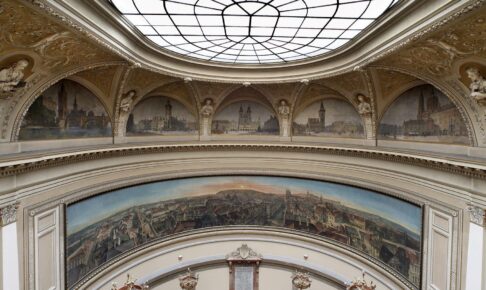Art and contemporary art in Central and Eastern Europe are still undeveloped or not well informed to Japanese people. This may be because geopolitical and political issues have been surfacing, and art and culture are often discussed based on the political system, which makes it difficult to understand. Also, historically, high art, such as fine art, belonged to aristocrats and royalty. Even today, art collectors and galleries are generally located in countries with high economic standards, and from this perspective, it would not be an exaggeration to say that art from Central and Eastern Europe under communism is still a minor art genre. However, the art culture and history of Central and Eastern Europe, with its complex mixture of borders, ethnic groups, religions, and languages, is very interesting.

The cultural landscape of Central and Eastern Europe is unique and vibrant, and has been shaped by a variety of geopolitical, ethnic, and social events over the last century. The arts – painting, sculpture, and the performing arts – have had a profound impact on the region’s history, reflecting changing times and influences. In this exhibition, we will explore the art of Central and Eastern Europe, looking at how geopolitical, ethnic, and post-World War II influences, as well as socialist regimes and the subsequent return to democracy, have affected the avant-garde art within the region and the international art scene.
>List of Art Museums in Central and Eastern Europe
>List of Art University & Art Academy in Central and Eastern Europe

目次
-Geopolitics
The history of Central and Eastern Europe is long and complex, and the art of the region reflects those boundaries, movements, and influences.
Over the centuries, the region has been a battleground for empires and ideological systems, leaving an indelible mark on culture and art. At various points in its history, the art of the region has been shaped by strong influences from Western Europe and Russia. In other words, there are strong ties between the art of the region and that of other countries, which have allowed Central and Eastern European art to develop its own style.
Before World War I, Central and Eastern Europe was home to different ethnic and cultural groups, each speaking different languages and holding different beliefs. The art practiced in each region, such as Polish Slavic painting or Armenian art painting, was often similar to the local culture and ethnicity. As tensions between nations increased and empires shifted, such as Hungarian Cubism and Romanian Futurism, regional art adapted; as empires collapsed in the 20th century, artwork also changed, with themes of nationalism and representations of newly formed countries and regions again appear.

-Ethnic
The cultural diversity of Central and Eastern Europe has contributed to a deepening of the arts. Many great works of art and cultural interpretations have emerged from different ethnic groups and their ideas about the ever-changing landscape.
The region is home to numerous ethnic groups, each with their own customs, religions, languages, and artistic traditions. As a result, different cultures and traditions are in constant exchange, creating a vibrant and diverse art scene.
For example, Prague painters of the 18th and 19th centuries adopted the unique artistic styles of Bohemia and Moravia, creating a highly textured and vibrant artistic style. Roma (also known as Gypsies) culture also played a major role in the region, and their traditional crafts and music greatly influenced the art and culture of Central and Eastern Europe. Many Roma artists combined their traditional culture with their own art and performance, becoming an important part of the art scene.

-After World War II
With the end of World War II, new borders, governments, and worldviews were formed in Central and Eastern Europe. The region was divided into two distinct political blocs and subjected to two different types of governance. The result was a distinct aesthetic characterized by a sense of hopelessness, insecurity, and fear. As the region was rebuilt, the art of the region began to explore themes of struggle and recovery, as well as the anguish of life in a divided world.

-Socialist Regimes
Like many countries in Eastern Europe, the Soviet Union had a profound impact on the art and culture of the region. Under its rule, art became a tool for the Soviet Union to maintain control of the region. Artists were encouraged to create works that supported party ideology and promoted the idea of a socialist state, resulting in a vast number of propaganda posters and public sculptures.
At the same time, art of the period often focused on the struggle for social justice and equality. Many artists chose to explore themes of exploitation, oppression, and injustice that were prevalent during this period, and they chose to give voice to the voiceless in their work. Art from this era also explored themes of hope and resilience as the people of the region endured through the darkness of the times.

-Avant-garde to Contemporary Artists
With the end of Stalin’s control of the arts and new freedoms, artists explored traditional and contemporary themes without fear of reprisal, creating new forms of expression such as installation art, performance art, and conceptual art.
After a period of political and social turmoil, art in Central and Eastern Europe underwent a period of transformation in the late 1990s. A new generation of avant-garde artists emerged, mixing modernism, expressionism, and surrealism. This new generation of artists aimed to break free from the constraints of the socialist system, and many of their works focused on themes of freedom, individualism, and self-expression.
Various styles and movements emerged and gained popularity, from Art Deco in Hungary to Jan Zrzavý in the Czech Republic, as well as the Colorists and Post-Impressionists. It was also a time when all kinds of art flourished, including abstract paintings and expressionist works. After World War II, avant-garde art, such as Hungarian neo-avant-garde and Czech surrealism, also flourished and became known worldwide.

-Summary
The 20th century art scene in Central and Eastern Europe was remarkably diverse. Central and Eastern European art has a long and complex history, shaped by geopolitics, ethnicity, World War II, and the socialist regimes of the 20th century, and it was not until the collapse of the region’s communist regime in 1989 that a new generation of avant-garde artists emerged and began exploring new and exciting directions. This period of dramatic change gave birth to a vibrant and diverse art scene that continues to evolve and develop to this day.















